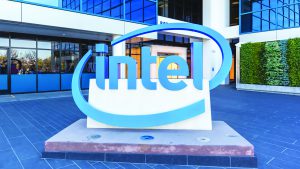BLOOMBERGÂ
Intel Corp shares jumped after the embattled chipmaker promised a recovery in the second half, leading investors to look past a disappointing profit-margin forecast in the current quarter.
The company predicted that gross margins — a closely watched measure — would begin to widen again in the back half of 2023. Intel is returning to full manufacturing capacity, and an inventory glut afflicting the personal computer market is nearing an end, executives said on a conference call. The upbeat remarks helped send the shares up 3.6% in premarket trading.
“You normally have a stronger second half in our industry, and we expect that to be the case,†Chief Executive Officer Pat Gelsinger said on the call. “We’re seeing some green shoots in the marketplace. But we think it’s a tough market for all.â€
The company also painted a more optimistic view of the broader PC industry, saying it expects shipments to reach 270 million units this year before increasing to about 300 million units annually in the future. That would put the total back above the level in 2022, when shipments began sliding.
Gelsinger is confronting a massive pileup of inventory, weak demand and the loss of market share — all of which contributed to a historic slump. At the same time, he’s trying to speed up the introduction of new production technology, a costly attempt to regain Intel’s industry leadership. But that effort — if successful — won’t bear fruit until 2025.
Investors have been skeptical that the chipmaker can catch up with rivals, and the stock plunged nearly 50% in 2022. Gelsinger argued that the company has begun to turn a corner.
“In the things that they can control, they’ve lived through the worst of that pain,†said Cody Acree, an analyst for Benchmark Co.
In the near term, Intel’s financial outlook still looks dim. It expects a loss of 4 cents a share in the second quarter, excluding some items, the company said. That compares with the 2-cent average estimate of analysts.
That initially sent shares down more than 2% in late trading, before a later rally. They had closed at $29.86, leaving them up 13% this year.
The revenue outlook was a bit brighter, with the company predicting sales of $11.5 billion to $12.5 billion. The midpoint of that range exceeds the average analyst estimate of $11.7 billion.
Intel predicted that gross margin — the portion of sales remaining after deducting the cost of production — would be 37.5% in the second quarter. That compares with an estimate of 41%.
The company has been running its factories at less than their full capacity, meaning it has to take “underloading†charges that crimp margins. While that headwind will recede as the company is able to increase output later this year, margins won’t rebound to where they once were until those plants are upgraded, according to Chief Financial Officer Dave Zinsner.
The factories need new manufacturing technologies that will be expensive to put in place. Once that happens — and Intel is competitive with rivals again — the company hopes to restore profitability to historical levels.
When its factories were home to the industry’s most cutting-edge production and its products were dominant in the server and PC markets, the company regularly posted a margin of more than 60%.
In the first quarter, Intel reported a loss of 4 cents a share, excluding some items, better than the 16-cent loss analysts had predicted. Revenue came in at $11.7 billion. That beat analysts’ projection of $11.1 billion, but sales has come down sharply in recent years. Intel had quarterly revenue of more than $20 billion as recently as 2021.
Client computing, Intel’s PC chip business, generated $5.8 billion in revenue. That compares with an estimate of $4.95 billion. Data-center sales were $3.7 billion, versus an average projection of $3.51 billion.
First-quarter PC shipments slumped 29% to 56.9 million units, taking them back below the levels of early 2019, according to IDC. That puts the industry on course to come in more than 100 million units shy of its 2021 total.
Intel’s strength in the server processor market once cushioned it from the ebb and flow of the PC business. Server chips, the central components of machines that run the internet and corporate networks, are much more expensive and profitable than those that go into laptops. But in that area, Intel has lost market share to rival Advanced Micro Devices Inc and in-house efforts by major customers such as Amazon.com Inc’s Amazon Web Services (AWS).
A slowdown in demand in the server and networking business hasn’t hit bottom yet, Intel executives said.
Overall, Intel gave enough positive news to raise investors’ spirits. But analysts like Benchmark’s Acree will be waiting for the company to follow through.
 The Gulf Time Newspaper One of the finest business newspapers in the UAE brought to you by our professional writers and editors.
The Gulf Time Newspaper One of the finest business newspapers in the UAE brought to you by our professional writers and editors.
